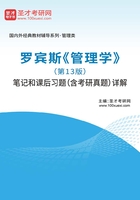
4.4 考研真题详解
一、概念题
1.特许经营(浙大2012年研;人大2009年研)
答:特许经营是指拥有经营权和专利权的法人为了迅速扩大业务,将自己的商标、商品和整套全部经营方法的使用权授予另一方,允许它按一定的规则经营特定业务的一种经营方式。它可以分为三类:①商品分销;②商品制造权和销售;③业务形式的特许经营。通过特许经营方式,经营者可以迅速获取经营的知识,减少自我摸索的时间,企业总部也可以借此方式快速扩张经营版图。特许经营是战略联盟的一种主要形式,其经营形式主要有资源加盟、委托加盟、特许加盟。
2.不确定性规避(浙大2012年研)
答:不确定性规避是霍夫斯泰德评估文化框架的维度之一。不确定性规避描述的是人们承受风险和非例行情况的程度。在不确定性规避程度低的社会中,人们或多或少都会对风险泰然处之。他们相对来说更能容忍不同于自己的行为和意见,因为他们并未感受到威胁。另一方面,在不确定性规避程度高的社会中,人们感到自己受到了不确定性和模糊性的威胁,并感到高度焦虑,具体表现为神经紧张、高度压力和进取心。
二、简答题
解释霍夫斯泰德的5个民族文化维度。(西安交大2012年研)
相关试题:霍夫斯泰德模型(概念题,东北财大2015年研)
答:民族文化是一个国家的居民共有的价值观,这些价值观塑造了他们的行为以及他们看待世界的方式。格尔特·霍夫斯泰德提出了评估文化的框架,其研究发现,管理者和员工在民族文化的五个维度方面表现不同。这五个维度分别是:个人主义与集体主义、权力差距、不确定性规避、生活的数量与质量、长期与短期导向性。
(1)个人主义与集体主义
个人主义是个体倾向于个人行动而不是作为群体成员行动的程度。在个人主义社会中,人们只关心自己和直系亲属的利益。在一个允许个人有相当大自由度的社会中这样做是可能的。集体主义以一种紧密结合的社会结构为特征。在这一结构中,人们希望群体中的其他人(诸如家庭或一个组织)在他们有困难时帮助并保护他们。
(2)权力差距
霍夫斯泰德使用权力差距这一术语作为衡量社会接受机构和组织内权力分配不平等程度的尺度。一个权力差距大的社会接受组织内权力的巨大差别,员工对权威显示出极大的尊敬。称号、头衔及地位是极其重要的。相反,权力差距小的社会尽可能地淡化不平等。上级仍拥有权威,但员工并不惧怕或畏惧老板。
(3)不确定性规避
不确定性规避描述的是人们承受风险和非例行情况的程度。在不确定性规避程度低的社会中,人们或多或少都会对风险泰然处之。他们相对来说更能容忍不同于自己的行为和意见,因为他们并未感受到威胁。另一方面,在不确定性规避程度高的社会中,人们感到自己受到了不确定性和模糊性的威胁,并感到高度焦虑,具体表现为神经紧张、高度压力和进取心。
(4)男性气质与女性气质
霍夫斯泰德提出了男性气质/女性气质的维度。男性气质反映对自信、金钱和物质商品以及竞争等价值观的追求程度,女性气质则强调对关系的敏感性以及对他人福利的关注。
(5)长期与短期导向性
该维度考察的是一个国家对生活和工作的取向。在长期导向性文化中,人们期待未来,重视节约和持之以恒。休闲时间并不是那么重要,人们相信生命中最重要的事件将在未来发生。短期导向性文化重视过去和现在,强调尊重传统和履行社会义务。休闲时间很重要,而且人们相信生命中最重要的事件发生在过去或现在。
三、案例分析题
Based on the following paragraph,write an essay highlighting why more and more Chinese companies are‘going global’and what challenges managers in Chinese MNCs are likely to face in managing globally?(对外经贸2010年研)
The globally integrated enterprise will require fundamentally different approaches to production,distribution, and work-force deployment.This is already happening.Because new technology and business models are allowing companies to treat their different functions and operations as component pieces,firms can pull those pieces apart and put them back together again in new combinations,based on strategic judgments about which operations the company wants to excel at and which it thinks are best suited to its partners.
Sustainable competitive advantage has never come only from productivity or inventiveness.Today more than ever,the premium comes from the fusion of invention and insight into how to transform how things are done.Real innovation is about more than the simple creation and launching of new products.It is also about how services are delivered,how business processes are integrated,how companies and institutions are managed,how knowledge is transferred,how public policies are formulated—and how enterprises,communities,and societies participate in and benefit from it all.
The spread of shared technologies and business standards is creating an unprecedented opportunity for further global integration,not just within each sector of society.but across them all.As the boundaries between the traditional“estates”become more porous,new businesses can contribute new forms of commerce, learning,and good governance.Government leaders will find in business willing partners to reform health care and education,secure the world′s trade lanes and electronic commerce,train and enable the displaced and dispossessed,grapple with environmental problems and infectious diseases,and tackle the myriad other challenges that globalization raises.
The alternative to global integration is not appealing.Left unaddressed, discontent with globalization will only grow.People might ultimately choose to elect governments that impose strict regulations on trade or labor,perhaps of a highly protectionist sort.Worse,they might gravitate toward more extreme forms of nationalism,xenophobia,and anti-modernism.
The shift from MNCS to globally integrated enterprises provides an opportunity to advance both business growth and societal progress.But it raises issues that are too big and too interconnected for business alone or government alone to solve.
The globally integrated enterprise is a promising new actor on the world stage.Now leaders in business,government,education,and all of civil society must learn about its emerging dynamics and help it mature in ways that will contribute to social, economic,and human progress around the planet.
Much of the growth in international business has been carried out by large businesses called MNCs.These large companies exist in an almost borderless world, encouraging the free flow of ideas,products,manufacturing,and marketing among countries to achieve the greatest efficiencies.
答:本案例讲的是新形势下企业国际化经营的问题。
(1)越来越多的中国公司走入国际市场的原因包括:
①利用全球资源降低成本。这点在文中也提到了,就是跨国经营可以利用各地的资源,每个地区具有比较优势的资源不同,利用各地的优势资源,可以降低企业的生产成本。
②有利于获得先进的技术。我国很多行业的生产技术水平相对落后,在国际上技术转让有一个规律:一流技术只在本土使用;当这个技术变为二流技术或有更新技术替代它时,发达国家才会将这一技术转移到发展中国家投资兴办独资企业。我国企业国际化经营可以通过本土化经营策略迅速获得国外的先进生产技术。
③跨国经营有利于扩大出口份额。相比较而言,国内生产出口成本高,受制于人,而且难以避免非关税壁垒,到海外建立生产经营实体就能很好地扩大出口份额。
④有助于更好地适应外部经营环境的变化。由于各个国家的环境不同,现在的经营环境变得更复杂和具有不确定性。国际化经营可以使企业具有全球化的视野,增强应对各种问题的能力。
⑤有助于提高企业的经营管理水平。国际化经营对企业提出了更高的经营管理要求,并要求合乎当地的法规和市场条件,这些都能促进企业完善自己的经营管理模式。
(2)在国际化经营中,中国的跨国公司的管理者面临的主要挑战是:
①外国政府的进入壁垒。外国政府带有地方保护主义,往往对其他国家的跨国经营有一定条件的限制,所以国际化经营面临政治风险。
②对国外的政策法规不熟悉。我国企业国际化经营需要了解当地的法律法规,而这正是我国企业经营者所欠缺的。
③对国外的市场环境不熟悉。我国企业国际化经营的市场经验不足,对别国的市场认识不够,本土化经营策略做的不好。
④对国外的文化不适应。国际文化是多样性的,但我国企业在国际化经营中往往仍遵循着本土的一套做法,而没有充分考虑当地的文化,从而导致了对国外文化的不适应。
⑤组织结构不适应全球化。我国企业在进行国际化经营的过程中可能需要进行组织结构变革,因为现在的结构还不能适应全球化发展的需要。
⑥缺乏国际化经营的人才。国际化经营需要具有跨国管理经验,对当地市场、经济、法律很了解的高级管理人才,而我们企业目前还很缺乏这种人才。